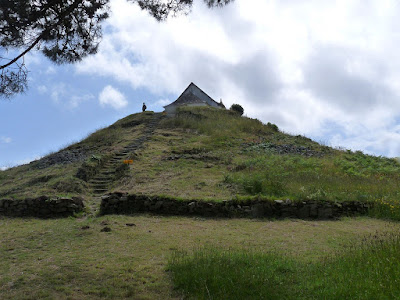In search of legendary “City of the Monkey God,” the NAT GEO Explorers find the untouched ruins of a vanished culture.
Lidar is able to map the ground even through dense rain forest, delineating any archaeological features that might be present.When the images were processed, they revealed unnatural features stretching for more than a mile through the valley. When Fisher analyzed the images, he found that the terrain along the river had been almost entirely reshaped by human hands.
The region also is gravely threatened. Deforestation for ranching has checkerboarded the jungle to within a dozen miles of the valley.
Huge swaths of virgin rain forest are being cut illegally and burned to make way for cattle. The region has become one of the biggest beef-producing areas in Central America, supplying meat to fast-food franchises in the United States.
****Lost City in the Honduran Rain Forest****
The most striking object emerging from the ground
is the head of what Fisher speculated might be “a were-jaguar,”(seen above in the picture) possibly
depicting a shaman in a transformed, spirit state. Alternatively, the
artifact might be related to ritualized ball games that were a feature
of pre-Columbian life in Mesoamerica.
“The figure seems to be wearing a helmet,” said Christopher Fisher, a Mesoamerican archaeologist on the team from Colorado State University, Team member Oscar Neil Cruz, head archaeologist at the Honduran Institute of Anthropology and History (IHAH), believes the artifacts date to A.D. 1000 to 1400.
Since the 1920s, several expeditions had searched for the White City, or Ciudad Blanca.
The eccentric explorer Theodore Morde mounted the most famous of these
in 1940, under the aegis of the Museum of the American Indian.
According to Morde, the indigenous people there
said it contained a giant, buried statue of a monkey god. He refused to
divulge the location out of fear, he said, that the site would be
looted. He later committed suicide and his site—if it existed at all—was
never identified.
The explorers were first unable to trace the exact location. But later with the help of LiDAR, they found the exact location.They identified a crater-shaped valley, encircled by steep mountains, as a possible location.
Lidar is able to map the ground even through dense rain forest, delineating any archaeological features that might be present.When the images were processed, they revealed unnatural features stretching for more than a mile through the valley. When Fisher analyzed the images, he found that the terrain along the river had been almost entirely reshaped by human hands.
The region also is gravely threatened. Deforestation for ranching has checkerboarded the jungle to within a dozen miles of the valley.
Huge swaths of virgin rain forest are being cut illegally and burned to make way for cattle. The region has become one of the biggest beef-producing areas in Central America, supplying meat to fast-food franchises in the United States.
The
expedition was launched after aerial light detection scanning — known
as LIDAR — uncovered what appeared to be man-made structures below the
rainforest. - See more at:
http://ancientexplorers.com/blog/national-geographic-news-lost-city-discovered-in-the-honduran-rain-forest/#sthash.yYFr6gnd.dpuf
The
expedition was launched after aerial light detection scanning — known
as LIDAR — uncovered what appeared to be man-made structures below the
rainforest. - See more at:
http://ancientexplorers.com/blog/national-geographic-news-lost-city-discovered-in-the-honduran-rain-forest/#sthash.yYFr6gnd.dpuf























































